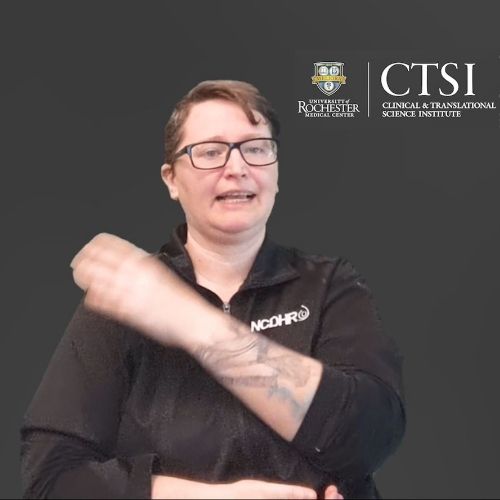Deaf Strong Hospital: Seeing Health Care through Deaf Eyes
Recently members of Rochester’s Deaf communities gave first year medical students at the University of Rochester Medical Center a taste of how they experience health care. For over ten years, the National Center for Deaf Health Research (NCDHR) at URMC has been hosting this interactive role-reversal exercise, called Deaf Strong Hospital.
The annual exercise casts UR medical students as “patients” and members of the local Deaf communities as doctors, pharmacists, receptionists, and other health care workers. The students must navigate through a mock healthcare system in which the primary language is American Sign Language (ASL). A small portion of the students have access to interpreter services as part of the exercise – similar to real life situations.
These are all things a Deaf individual might experience when trying to access health care. Since they are also not automatically identifiable as deaf, they may miss their name being called in a waiting room. Also, depending on where they go, interpreter services may not be available, prompt, or sufficient.
“The health care system needs to be more accessible for those who are deaf and/or hard of hearing,” said Kelly Matthews, Outreach and Research Coordinator with NCDHR, “from making the phone call to set up the appointment to having a qualified interpreter present at appointments.”
For Deaf individuals, emergency situations can be particularly precarious. During the annual lecture that accompanies Deaf Strong Hospital, UR medical student Ian DeAndrea-Lazarus, who is Deaf, gave several personal accounts of miscommunications that can occur when Deaf individuals find themselves in emergency situations. When his wife fell and hit her head on concrete at a NY Giants training camp in New Jersey, EMTs mistakenly labeled her “unresponsive”, not realizing she is Deaf. Luckily, Ian was able to communicate with the EMTs, preventing her from receiving a diagnosis much graver than her medical condition required.
Deaf Strong Hospital is an opportunity for our future physicians to walk a mile in a Deaf person’s shoes – to bring accessibility issues to their attention at the beginning of their career. Ultimately, the aim of this approach is to improve healthcare access.
“It really teaches us to be more conscious of cultural differences - making sure we have interpreters in our clinics and in hospitals and really taking the time out to make sure that we’re both on the same page when we have that interaction,” UR first year medical student Fatima Bawany told 13WHAM’s Justin Carter at the event.
This program, which has opened the minds of many medical students over the past ten years, would not be possible without the members of Rochester’s Deaf communities who commit their time every year. Their dedication to Deaf Strong Hospital is the key to its success.
The Rochester Prevention Research Center: National Center for Deaf Health Research (NCDHR) is organizationally housed within the CTSI and is funded in-part by the Centers for Disease Control and Prevention through the Prevention Research Centers program. The contents of this article represent the views of the author, and do not necessarily represent the official position of the funders.
Michael Hazard | 9/20/2016



